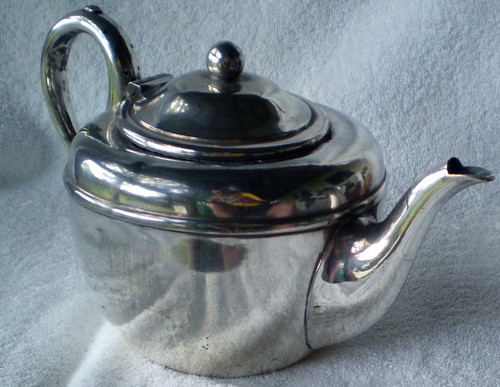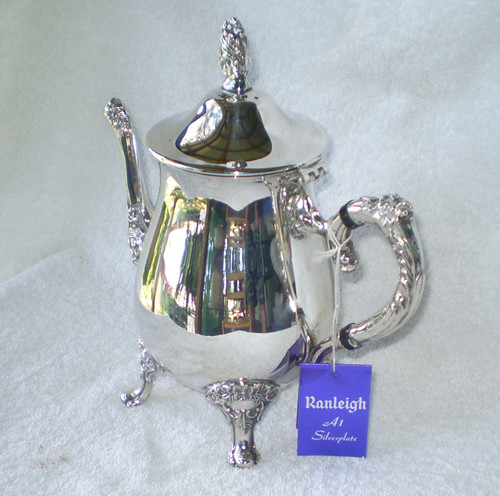HISTORY
While we do not usually offer items on other people's behalf, a family member has asked us to see if 'someone' may like some of their silver plate flatware/hollowares and cutlery sets.
I like a story (true of course), who doesn't? We were handed a lot of oldish Silver plate by this family member, some of which is on our website and then there were items like this! Very old, very dirty and unloved looking ... it had seen much better days.
I asked them where on earth they got this from and apparently it was purchased here in Australia many, many moons ago because the maker, James Dixon & Son had offices here in Australia a long time ago.
This is Silver plated holloware (teapot) but with a difference, it uses the less common Electro-plated Brittania metal base, not the usual Nickel base. That is the reason for the EPBM on the underside instead of EPNS
Brittania metal based products were of the "lower classes" in the world of Silver plate, being a lower cost alternative to the standard Nickel plated products from Silversmiths. These days the EPBM products are becoming very difficult to find - most people just threw them out! The biggest problem with EPBM is not the Silver plating but the fact that Brittania base metal (mostly Tin) is much softer than other electroplating base metals and prone to showing knocks and dents.
These are the reasons for the owners referring to this teapot as "the old tart", she's a little battered, old and originally of a lower cost compared to other Silver plate wares but 'dressed up' to look like them"
As to the Silversmith who made this teapot, their company is steeped in traditional and a well known English company in the world of Sterling and Silver Plated products, unfortunately they did strike hard times and the name was sold to others in the 1980's I think. The company was considered one of the most prestigious in England, recognized for its excellence in both sterling silver and silver-plated items, including tableware, tea sets, and decorative hollowware. This means that although this teapot is in the EPBM class, it was crafted to a high standard. As always in the world of production, cost pressures (and so the retail selling prices) were very competitive, this move into EPBM would have been part of that move to reduce costs and eventually (around the same time ... late 1920's) James Dixon & Sons was moving into Stainless Steel wear for cost reasons.
So now you can perhaps understand a little better of the "family history" this teapot has experienced, now she needs to find a new caring home (even if just for viewing, a bit like a rest home!)
You can easily see all the other Silver plate ware by clicking HERE
JAMES DIXON & SON - Teapot With Hinged Lid
Made in Sheffield, Great Britain
Circa 1880 ~ 1927 period, based on the use of the trumpet & bugle graphics at the top of the underside hallmark. After some discussion with those who had this teapot, it was decided that the late 1920's was the most likely period when this teapot was made
Silverplate (E.P.B.M)
Brittania base metal, primarily Tin
Assumed to be A1 grade plating although this is not stated, we couldn't image this company producing inferior plated products!
"Standard" teapot design but note the holes top and bottom of the handle, these are for ventilation and to allow for the hollow handle construction. Inside there is the nice fine tea leaf filter at the spout, actually a really nice filter which has small (but not too small) holes to allow the tea to pour and trap the tea leaves (hopefully).
Hinged lid with button handle
DIMENSIONS:
Stands 130mm high, including the top ornate lid handle
235mm is the entire length of the teapot, including the spout and large open handle (great for the "big-handed ones" of the household.
Weight: 450g (without water/tea inside!)
COSMETIC CONDITION:
USED (I would estimate quite a bit, normal for a teapot)
CLEAN (Well ... externally yes, internally I haven't even tried!)
High lustre (Oh my! you do scrub up well don't you?)
Now, let me tell you a bit about the finish, dents and damage - this old girl is about to have her 100th birthday, she is no spring chicken and you can see that!
When we first received the teapot, good God it was Black all over and not looking great at all. I cleaned and cleaned manually with a little metal polish and then when I was making headway, I switched to Bi-Carb Soda with Al foil. Then more (LOTS more) rubbing with a soft cloth. Believe me it was tough work removing all those years of oxidisation, dirt, dust and grime.
I worked ONLY on the outside, not inside the teapot. It still remains dark, Blackish and something I wouldn't want to drink tea from!
After all my work, she has scrubbed up pretty well - nice in fact! I have left a few areas with work still needed to bring them up to scratch or just leave them so others can see a little patina (if that is your "thing")
I did NOT notice any failure of the plating, just dirty in places e.g around the lip, the hinge and inside the handle was hard to get to as well.
There is some minor dents to the top/side area but these are not large dents - battle wounds if you like.
There is REAL DAMAGE though ... lift up the lid and look inside ... there is a rolled edge around the lip or mouth of the teapot and part of this has drifted from the side of the teapot. Still useable but visually unattractive! You may be able to see this in the photographs, take a look in the area of the spout (topside).
Minimal surface scratches observed at all - although I must say that I noticed something interesting ... when held in sunlight "just the right way" the Silver surface looks almost like it is in sheets, as though it is an applied layer. This can only be seen when the light is reflecting off the Silver plate just the right way.
NO pitting or oxide "spotting" observed at all
To preserve the current condition, I have placed this teapot within a completely sealed clear plastic packaging (airtight) in the hope of reducing any further tarnishing to the external Silver finish.
So there you have our rather long winded story, we care about these things and like to try and give as much information as possible, including the background ... we think this is better than someone (lot's do this online) saying "here's an old teapot - Want it?"














